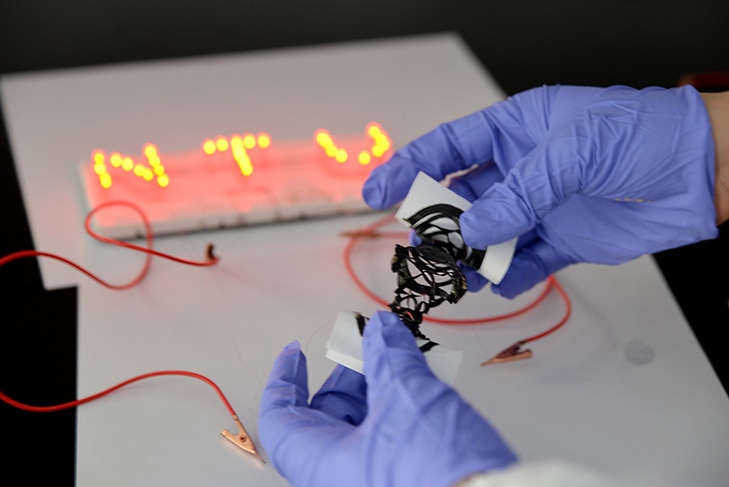Jan 31 2018
Researchers at Nanyang Technological University, Singapore (NTU Singapore) have developed a customizable, fabric-like power source that can be cut, stretched or folded without losing its function.
 Image credit: NTU SINGAPORE
Image credit: NTU SINGAPORE
Headed by Professor Chen Xiaodong, Associate Chair (Faculty) at the School of Materials Science & Engineering, the research team reported in the Advanced Materials journal (print edition 8 January) how they have designed the wearable power source, a supercapacitor, which operates like a rapid-charging battery and can be recharged many times.
Significantly, they have made their supercapacitor customizable or “editable”, meaning its shape and structure can be altered after it is manufactured, while keeping its function as a power source. Current stretchable supercapacitors are formed into predetermined designs and structures, but the new invention can be stretched multi-directionally, and is less likely to be incompatible when it is joined up to other electrical components.
The new supercapacitor, when corrected into a honeycomb-like structure, has the ability to store an electrical charge four times higher than most current stretchable supercapacitors. Furthermore, when stretched to four times its original length, it maintains almost 98% of the initial ability to store electrical energy, even after 10,000 stretch-and-release cycles.
Experiments conducted by Prof Chen and his team also revealed that when the editable supercapacitor was paired with a sensor and positioned on the human elbow, it performed better than current stretchable supercapacitors. The editable supercapacitor was able to provide a stable stream of signals even when the arm was swinging, which are then conveyed wirelessly to external devices, such as one that records a patient’s heart rate.
The researchers believe that the editable supercapacitor could be easily mass-produced as it would depend on current manufacturing technologies. Production cost will therefore be low, estimated at around SGD$0.13 (USD$0.10) to create 1 cm2 of the material.
The researchers have filed a patent for the technology.
A reliable and editable supercapacitor is important for development of the wearable electronics industry. It also opens up all sorts of possibilities in the realm of the ‘Internet-of-Things’ when wearable electronics can reliably power themselves and connect and communicate with appliances in the home and other environments.
My own dream is to one day combine our flexible supercapacitors with wearable sensors for health and sports performance diagnostics. With the ability for wearable electronics to power themselves, you could imagine the day when we create a device that could be used to monitor a marathon runner during a race with great sensitivity, detecting signals from both under and over-exertion.
Professor Chen Xiaodong, Associate Chair (Faculty) at the School of Materials Science & Engineering
The editable supercapacitor is composed of strengthened manganese dioxide nanowire composite material. While manganese dioxide is a common material for supercapacitors, the ultralong nanowire structure, reinforced with a system of carbon nanotubes and nanocellulose fibers, allows the electrodes to endure the associated strains during the customization process.
The NTU team also partnered with Dr. Loh Xian Jun, Senior Scientist and Head of the Soft Materials Department at the Institute of Materials Research and Engineering (IMRE), Agency for Science, Technology and Research (A*STAR).
Customisable and versatile, these interconnected, fabric-like power sources are able to offer a plug-and-play functionality while maintaining good performance. Being highly stretchable, these flexible power sources are promising next-generation ‘fabric’ energy storage devices that could be integrated into wearable electronics.
Dr. Loh Xian Jun, Senior Scientist & Head of the Soft Materials Department at the Institute of Materials Research and Engineering (IMRE)